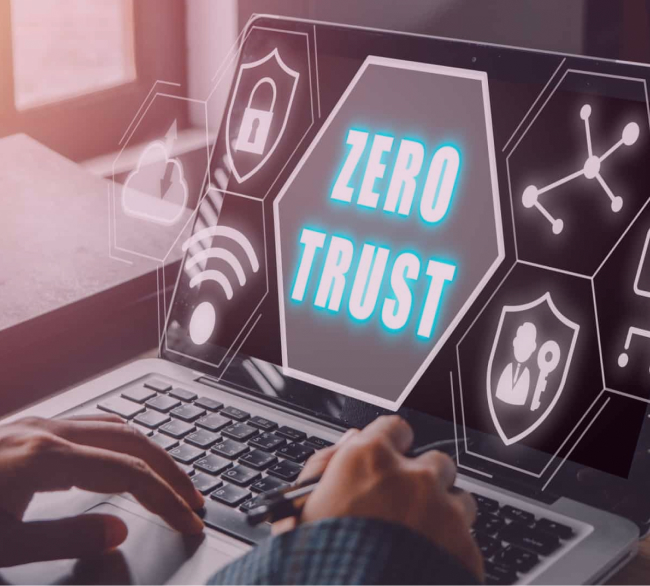Zero Trust Security (ZTS) is a fundamental cybersecurity approach that eliminates the concept of trust from an organization’s network infrastructure or architecture.
With its core objective being the protection of advanced digital environments, the technology leverages network segmentation to provide 7-layer-based threat protection, simplify granular user access control and prevent lateral movement.
Leveraging ZTS provides benefits to modern organizations. Risks such as data breaches, malware, and ransomware are significantly reduced as strict controls and proactive user credential verification guarantee optimal security.
The enhanced visibility into activities allows the organization’s IT team to timely intervene and remediate risk while real-time analytical reports allow professionals to look into risks at a granular level, allowing them to uncover the root cause of risks.
ZTS is also a compliance enabler as it allows companies to demonstrate adherence to cybersecurity laws enacted and monitored by regulatory authorities such as the U.S. Department of Justice.
Though the technology is promising, implementing it can be challenging. It requires robust knowledge and implementation expertise to deploy ZTS in the organization.
Achieving comprehensive visibility and control over all network systems is a technical task requiring a specialized skill set.
The substantial changes to the existing network infrastructure that ZTS demands can be costly and complex let alone require a cultural shift in the organization.
This blog provides a step-by-step implementation guide to help professionals and organizations leverage ZTS to:
- Enhance cybersecurity protocols
- Reduce cost
- Overcome complexity
- Improve network infrastructure
- Reduce the risk of data breaches
- More.
Let’s get started!
What is Zero Trust Security in IT and its Core Principles?
The Zero Trust security principles/model was first introduced by John Kindervag. John was a former analyst at Forrester Research in 2010.
He came up with the term and introduced us to the concept of “never trust, always verify,” which is also a fundamental principle of Zero Trust.
Hence, the core Zero Trust security principle revolves around trusting no one and verifying everything, focusing on user and device-based security.
This cybersecurity approach operates on the principle of verifying and validating the credentials of all users before granting access.
The security model is built on several components each of which plays a distinctive part in enhancing your organization’s security stature.
Identity and Access Management (IAM) ensures and allows only verified users and devices to access organizational resources and private data. The multi-factor authentication and continuous monitoring add further security.
The micro-segmentation divides the network into isolated segments.
This makes it challenging for threats to break in and impact your organization’s network infrastructure as it limits lateral movement.
Least privilege access provides users and devices the minimum level of access, reducing the potential damage from unknown devices in case of a breach.
Next comes the continuous monitoring and analytics that provide real-time access to ground-breaking insights, allowing IT leaders to proactively detect and respond to threats, a benefit that is generally not available when the organization is leveraging a legacy IT security system.
However, a robust understanding of the Zero Trust Security principles and key components is essential to building, integrating, and leveraging this security model to its fullest potential.
The identification of potential vulnerabilities, planning for an effective contingencies plan, and ensuring that all security layers are performing efficiently would depend on this.
Moreover, a robust understanding would also play a critical role in educating your employees on how to best utilize the Zero Trust Security model, manage and maintain their roles, and bring a cultural transformation, one that involves optimal IT security.
How to Plan Effective Zero Trust Security Implementation?

Like any other plan, the plan of implementing Zero Trust Security principles in your organization can involve several steps.
All of the steps involved are complex, technical and require experts to implement effectively and successfully.
Partnering with an IT consulting services provider can also help in the process of implementing Zero Trust Security in your organization, reduce the cost involved, and expedite the entire process while ensuring efficiency.
You can also opt for developing a zero-trust architecture diagram to guide your ZTS implementation.
With that out of the way, let’s get on to the steps involved in implementing Zero Trust Security in your organization:
- Identify sensitive data and its location to determine the level of protection required.
- Mapping transaction flows is critical to identifying vulnerabilities and areas that require additional security measures to protect.
- Least privilege access, as discussed earlier, is crucial to implement as it limits the level of access granted to users and provides only the access they need. This significantly reduces the risk of unauthorized access and potential data breaches.
- Inspecting and logging all traffic maintains visibility and control over your network. This ensures prompt detection and response to suspicious activities.
While planning for Zero Trust Security, it is essential to think about all the risks and opportunities involved in the process.
For instance, the two risks involved in implementing ZTS include potential operational disruption during implementation and user pushback due to perceived inconvenience.
On the other hand, the benefits of implementing ZTS far outweigh the disadvantages.
For example, ZTS provides enhanced security and reduces the risk of data breaches and cyber-attacks.
With continuous monitoring and real-time analytics, organizations get to dive deep into their IT data to uncover the root cause of risks and it improves adherence with applicable regulations.
Moreover, understanding the core components of ZTS like network segmentation, user identity verification, ongoing security checks, and system health checks is integral and allows IT leaders and organizations to effectively plan ZTS implementation.
Since, it’s always best to tailor ZTS implementation per the organization’s specific demands, understanding the core components would help in determining vulnerabilities, and threats and laying out an advanced-level ZTS implementation strategy.
What Are the Best Practices for Implementing Zero Trust Security in IT?
ZTS demands a strategy approach that starts by building a foundation for creating effective policies and controls. Here’s a complete checklist that will enable you to ensure effective ZTS implementation in your organization:
Zero Trust Strategy Foundation Checklist
- Know Your Sensitive Data
- Where it lives
- How it’s classified (e.g., PII, financial, IP)
- Who owns it
- Understand Data Flows
- How it moves across environments (on-prem, cloud, hybrid)
- What apps, APIs, or third parties touch it
- Patterns of typical usage
- Map Access Controls
- Who has access to what (users, devices, services)
- How access is granted (RBAC, ABAC, temporary roles)
- What access paths exist (VPNs, direct, lateral movement)
Additional Key Areas to Lock In
- Asset Inventory & Visibility
- Devices, endpoints, workloads, containers
- Shadow IT detection
- Real-time monitoring for new or unmanaged assets
- Identity & Authentication Hardening
- Strong Identity Provider (IdP) setup
- MFA
- Conditional access policies
- Least privilege enforcement
- Micro-Segmentation
- Break the network into smaller zones
- Control East-West traffic
- Apply granular security policies based on identity/context
- Continuous Monitoring & Threat Detection
- Behavioral analytics
- UEBA, SIEM, and XDR integrations
- Real-time alerting and response playbooks
- Policy Engine & Enforcement Points
- Centralized policy decision points
- Local enforcement (firewalls, endpoint agents, API gateways)
- Automation for dynamic policy adjustments
- Compliance Mapping & Governance
- Map controls to frameworks (NIST 800-207, ISO 27001, etc.)
- Audit logs for every access event
- Reporting for stakeholders and regulators
- User and Entity Behavior Analytics (UEBA)
- Baseline normal behavior
- Flag anomalies (e.g., sudden access from a new geo/device)
- Feed into automated decision-making
Additionally, adopting a privileged access strategy and granting users only the minimum necessary access. You can access their roles and responsibilities based on which authority or access can be provided.
Regularly review and adjust these privileges to prevent privilege creep.
Leverage micro-segmentation to limit the lateral movement of threats. Divide your existing network into secure zones to isolate critical assets and data from potential threats.
Utilize multi-factor authentication or MFA as it adds an extra layer of security and allows only genuine users to access systems.
An IT consulting company working on their client’s information infrastructure would implement some of the best practices outlined above to assure optimal threat protection.
What are the Challenges Associated with Implementing Zero Trust Security?

The common challenges that leaders and organizations experience while implementing ZTS are a by-product of the common mistakes that can occur while implementing it.
These mistakes can be, rushing the implementation of ZTS or neglecting training for internal staff on how to implement ZTS.
If in case, such mistakes have been made while implementing ZTS, it is best to hire IT consulting services to get the job done effectively.
As for the challenges, the first few related aspects are design complexity, integrations, requirements, resistance to change, potential performance and cultural impact, and budget constraints.
To reduce challenges and implement ZTS successfully, C-level IT professionals can opt for the phased approach.
The first phase involves critical assets and gradually extends to less critical aspects. This would significantly minimize complexity and enable companies to stick to their budget.
Deep-level training would allow companies to upskill their internal employees, enabling efficient cultural shifts. In addition to this, hiring skilled professionals would also help minimize ZTS complexities.
A security-conscious culture would further add to the elimination of resistance to change. Training for all employees can be designed and implemented.
Automation further reduces ZTS complexity and burden on internal IT teams. A key consideration would be to hire IT consulting services.
Working with an IT consulting company would eliminate the burden on internal teams and get ZTS implemented effectively.
Moreover, conduct thorough testing to identify and remediate any issues that could disrupt ongoing ZTS implementation.
Determining that your infrastructure can handle additional load i.e., implementation of ZTS would help in the process.
The second most prioritized activity that you can do to minimize risks associated with ZTS implementation is measuring its effectiveness.
Periodic audits, reviews, testing, and leveraging insights into system performance are key to measuring the effectiveness of ZTs.
Key metrics like the total number of prevented reaches, user-compliance level, and system up-time would help in gauging the effectiveness. You can also go for regular penetration testing to ensure system robustness.
Finally, you have to get rid of the thought that ZTS is a one-size-fits-all solution. The best way to leverage it is to understand your current IT infrastructure, set realistic goals, determine the resources required, and enhance your security posture.
Moreover, you can regularly monitor and update your ZTS strategy to stay ahead of evolving threats.
Let’s take a look at measuring the effectiveness of ZTS in detail.
How to Measure the Effectiveness of Zero Trust Security Implementation?
To measure the effectiveness of ZTS implementation, IT leaders need to look at a few key metrics. These metrics are:
- Reduction in security incidents
- User behavior analytics (UBA)
- Network traffic analysis (NTA)
- Security incident response time
- Compliance with policies
Let’s go over them one by one. The reduction in security incidents such as threats or cyber-attacks indicates that you’ve successfully implemented ZTS.
UBA and NTA help in the prompt detection of potential threats by continuously monitoring user behavior and incoming network traffic.
Faster response time to security risks is a primary indicator of an effective ZTS model and while ZTS is handling your security, you should conduct regular audits to ensure adherence to ZTS policies.
These metrics also align with the best practices that are mentioned earlier like least-privilege access, continuous monitoring, or micro-segmentation.
Through regular tracking and analysis of such metrics, companies can identify areas for improvement, enhance their ZTS strategy, and maintain a robust security posture.
How to Ensure Continuous Improvement in Zero Trust Security Implementation?
To continuously improve your ZTS infrastructure, you need to implement a proactive and iterative approach – one that involves continuous testing, tweaks, customizations, regular monitoring and updates, and consistency in educating all users.
The process involves continuous improvement and audits of the ZTS framework that you’ve implemented.
Such audits should be directed toward verifying the efficiency of security policies, system performance, and access controls.
One way to massively enhance system performance is by leveraging AI and machine learning to detect anomalies and improve response time.
AI can easily assess the threats your organization has been exposed to in the past and specifically pinpoint threats or suspicious activities, directing your attention toward them for prompt intervention and risk remediation.
Overcoming challenges in ZTS implementation such as securing IoT devices, integrating legacy systems, and managing user access, can also be improved by identifying gaps, weaknesses, and areas for enhancement.
Such challenges can only be addressed by leveraging a combination of technologies and training.
Additionally, resistance to change can be mitigated via effective communication and training.
Regular training and awareness programs are crucial as they serve as a constant reminder to all employees, helping them realize what’s at stake.
The education also guides staff on Zero Trust security principles and potential security threats, minimizing risks and reducing the possibility of human error.
Therefore, effective communication and training modules should be the two primary aspects of a ZTS infrastructure.
IT leaders should ensure that employees are well informed of the threats that the organization faces and how they can help mitigate risks.
This would help in the development of a security-focused culture.
With budget constraints being the talk of the town these days – let’s discuss how they present an opportunity for ZTS implementation.
Budget constraints can lead to innovation.
IT leaders can focus on cutting down all unnecessary items and focus on developing a cost-effective solution that enables the organization to manage ZTS with limited resources and capabilities effectively.
The Role of Network Security Management in Zero Trust Security

Network security management plays a vital role in bringing a Zero Trust Security principles-based model to life.
At its core, Zero Trust is all about the idea of “never trust, always verify.” To make that work, you need strong oversight of your network.
Knowing what’s on it, who’s trying to access it, and whether they should be allowed to.
A few key pieces come into play here.
First, it’s important to identify and classify the data moving across your network, so you know what needs the most protection.
Then, there’s continuous monitoring – keeping an eye on traffic at all times to catch anything unusual.
Finally, enforcing least privilege access ensures users only get the access they need, nothing more.
Every request is verified and logged, which aligns perfectly with the Zero Trust mindset.
By managing network security effectively, you create a framework that supports constant verification.
It helps uncover and address vulnerabilities early, shrinking the potential attack surface.
You also gain real-time visibility into what’s happening across your network – an essential part of spotting and reacting to threats quickly.
As threats evolve, so should your approach.
Continuous improvement is a must. That means regularly reviewing and updating your security tools, policies, and procedures.
This ongoing effort not only keeps your defenses current but also builds a more proactive security culture across the organization.
In the long run, that kind of adaptability is what makes a zero-trust strategy both effective and sustainable.
Managing Technical Vulnerabilities in a Zero Trust Security Framework

In Zero Trust Security (ZTS) – one area that cannot be overlooked is Technical Vulnerability Management or TVM.
TVM is a key element in developing a strong, resilient security strategy.
It’s about finding weaknesses and gaps in your existing systems and software, understanding how serious the vulnerabilities are, and how to address them effectively while keeping track of everything along the way.
This means running regular vulnerability scans, identifying the issues that pose risks, and making sure updates are applied quickly, especially for high-priority risks.
Since new risks emerge constantly, ongoing monitoring is essential to staying ahead of potential attacks.
TVM also supports the core Zero Trust principle of “never trust, always verify.” By reducing the number of potential entry points for attackers, TVM helps lower the risk of a breach and strengthens the overall security posture.
Another critical aspect is how information is shared within the organization.
Effective communication plays a big role in TVM, especially when quick action is needed.
Sharing vulnerability data securely and efficiently ensures that the right people can respond in time.
This includes using secure communication channels, encrypting data, and storing sensitive information in a way that prevents unauthorized access.
Zero Trust Examples of Globally Recognized Organizations
- Google (BeyondCorp)
- Microsoft
- U.S. Department of Defense (DoD)
- IBM
- Cisco
- Okta
- Capital One
What Comes After Implementation?
With Zero Trust in place, the work isn’t over. That’s when ongoing maintenance becomes even more important.
Regular system reviews, timely updates, and patch management are essential. It’s also a good idea to keep staff trained and up to date on evolving threats and best practices.
Cybersecurity is always changing, and so should your approach.
A successful Zero Trust strategy requires a deep understanding of how your organization operates from the technology in use to how data moves through your systems and how users behave.
Ensuring adaptability and commitment to improvement is key to staying secure in a constantly shifting landscape of threats that businesses face today.

